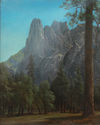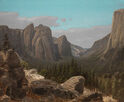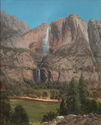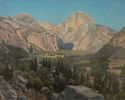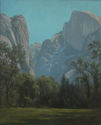
19th, 20th & 21st Century Fine Prints
707-546-7352 · fax 707-546-7924 · web: www.annexgalleries.com · email: artannex@aol.com
James David Smillie - Paintings of the Yo-Semite - Introduction
Over many years artist James David Smillie summered in the Catskills, the Adirondacks, and the White Mountains where scenery provided ample inspiration for his paintings. He also explored the Rocky Mountains in Colorado and, in the summer of 1871, James and his brother George traveled by train from New York to the state of California. They boarded a stagecoach in the San Joaquin valley and then at Clark's Ranch their baggage was transferred to mules while they mounted horses for the remaining distance to Yosemite via the Mariposa Grove of Giant Sequoias. The brothers were in Yosemite from June through September and James produced a number of oil paintings and drawings. From the renderings and the journal posts made during this extended visit, James D. Smillie created illustrations and wrote the text for the Yosemite section of Picturesque America published in 1872.
The Ahwaheechee were the main residents of Yosemite Valley for generations. In 1833, John Rutherford Walker and a group of explorers entered the Yosemite Valley and it is speculated that they were the first non-Indians to visit the area. The 1849 California gold rush brought hordes of miners and setters to the region and several years later a militia was organized to kill the Indians. In 1855, James Mason Hutchings organized the first tourist party, which included the artist Thomas Ayres. The artwork produced by Ayres during that trip is attributed to awakening the nation to the wonders of nature waiting to be discovered in Yosemite. The following year a trail allowing for easier access by tourists was completed on the Mariposa side.
Conservationists Frederick Law Olmsted and I. W. Raymond campaigned to protect the natural beauty and the fragile eco-systems of the region from commercial exploitation. Yosemite was first protected by the Yosemite Grant Act, which was signed on June 30, 1864, by President Abraham Lincoln during the Civil War. Under the grant, 39,000 acres of Yosemite Valley and the Mariposa Grove of Giant Sequoias were ceded to the State of California. It was the first territory ever set aside by Congress for public use and preservation. The Yosemite Grant Act created the foundation for the California State Park System.
In 1889, environmentalists John Muir and Robert Underwood Johnson lobbied for national park status for the wilderness area surrounding the Yosemite Valley. On October 1, 1890, the United States Congress set aside more than 1,500 square miles of reserved forestlands and President Benjamin Harrison designated the region as Yosemite National Park, making it the third national park in the nation.
President Theodore Roosevelt camped with John Muir in Yosemite in 1903. About his experience he wrote: “It was like lying in a great solemn cathedral, far vaster and more beautiful than any built by the hand of man.” Muir convinced both Roosevelt and California Governor George Pardee that the state needed to recede the 39,000 acres protected by the Yosemite Grant Act to the federal government and allow them to become part of the Yosemite National Park. In 1906 the borders of Yosemite National Park expanded to include those original protected acres. The United States Cavalry managed Yosemite until 1916 when the newly created National Park Service took over the management.
Imagine if you can, entering Yosemite in 1871 on horseback, pack mule, or riding in a stagecoach. Before you lies the staggering majesty of the El Capitan or Cathedral Rocks, the mists and thunder of the waterfalls, the long fertile valley sectioned by the Merced River, and the incomprehensible height of the Giant Sequoias. Missing from the scene is the modern day urbanization that we now find in the forms of hotels, cabins, parking lots, paved roads, tourists busses, and visitors. Four million people visit Yosemite each year. Many people explored Yosemite before James D. and George Smillie arrived in 1871.
In The Yosemite section of Picturesque America, Smillie wrote about his introduction to the grove of giant sequoias and his entry into the Yosemite:
"The trail was well worn and easy, the air gloriously pure, and the forest delightful. It would be useless to attempt to describe the confusion of sentiment and impatience that possessed me as I rode along, peering anxiously through the labyrinth of the wood for the first glimpse into the vast portals of that grand old grove….the afternoon, rich in contrasts of glowing lights and broad shadows, too quickly followed the inquisitive glare of noonday sun; pictures in effect and color presented themselves where, an hour before, there had been only a confusion of petty forms, sharp and shadowless, under the almost perpendicular rays of sunlight; the novelty of first acquaintance was wearing off, and the true grandeur of proportions was developing with fascinating rapidity….Every change of position presented some new charm–trees grouped into picturesque foregrounds, finding bold relief in light and shade against the opal and amethyst tints of distant granite cliffs; flowers nodding in the breeze that brought refreshment to the brow and music to the ear; the little streams dimpling and gurgling across the trail, as if unconscious of the terrible leaps that must be taken before reaching the river below. In strong contrast to this living, moving beauty, beyond all, the walls, towers, and domes of the Yosemite rose grand, serene, impassive, broadly divided into tenderest shadow and sweetest sunlight, giving no impression of cold, implacable, unyielding granite, but of majesty, to which our heart went out as readily as to the flowers and brooks at our feet….At last, the foot of the descent was reached, and away we cantered in the evening shades, the black-oaks lacing their branches overhead. Trees, bending in graceful framework, enclosed various pictures, one of the most charming being a view of the Bridal-veil Fall as it sprung over the wall nine hundred feet high. Its upper part sparkled a moment in the sunlight, a solid body; then as though wrestling with invisible spirits, it swept into a wild swirl of spray that came eddying down in soft mists and formless showers. Emerging from the wood, a broad meadow lay before us; and high over all projected, far up against the eastern sky, the Cathedral Rocks, with buttresses cool and spires aglow. At their foot the river crowds so close that the trail is forced to find its way through a wilderness of great granite blocks, that lie embowered in a forest which has grown since they were hurled from their places on the cliffs above. Then followed a long level, and groves of pine and cedar. After the fatigue and excitement of the day, it was like entering a sanctuary, the spirit of the place was so solemn and full of rest. There was no sentiment of gloom, but rather of deep, slumberous repose; the thick carpeting of sienna-colored pine-spindles that covered the ground hushed each foot-fall; the pillared tree-trunks form vistas that stretched, like "long-drawn aisles," to profoundest forest-depths; the branches, "intricately crossed," did not obscure the luminous sky above, or hide the tall cathedral-spires that burned ruddy in the last glean of day; refreshment and invigoration were in the very atmosphere…"
As Yosemite celebrates its 125th anniversary as a national park, it seems fitting to bring to the public's eye James David Smillie's oils painted 144 years ago in Yosemite.
The six oil paintings that the gallery is featuring were painted during Smillie's 1871 summer trip to Yosemite. Some are painted on canvas and others are painted on gessoed paper; their subjects being Sentinel Rock, Cathedral Rocks, Half Dome, Yosemite Falls, and Mt. Watkins. These painting were held by Smillie’s great granddaughter and passed down to his great, great grandson. Half Dome. Yo-Semite was included in the exhibition James David Smillie at the M. H. de Young Memorial Museum in 1978. Sentinel Rock YoSemite was include in the exhibitions Views of Yosemite at the Fresno Art Center in 1982, and California's Western Heritage at the Palm Springs Desert Museum in 1986. Study from Nature/ The Great Fall of the Yosemite was included in Views of Yosemite, and The Domes. Yo-Semite was included in Views of Yosemite and California's Western Heritage.
These paintings are a reminder of the debt owed those early conservationists who recognized that the majesty of this splendid natural setting had to be protected for generations to come.

